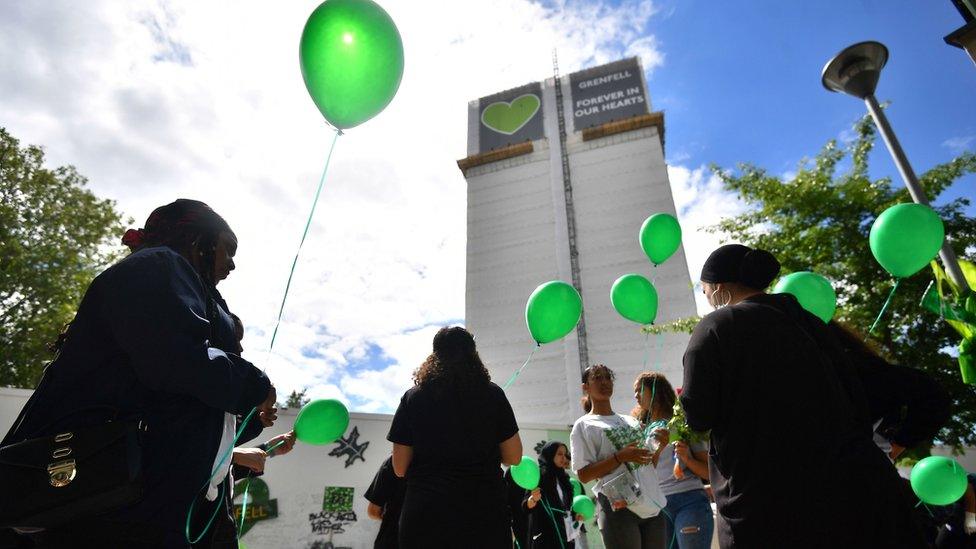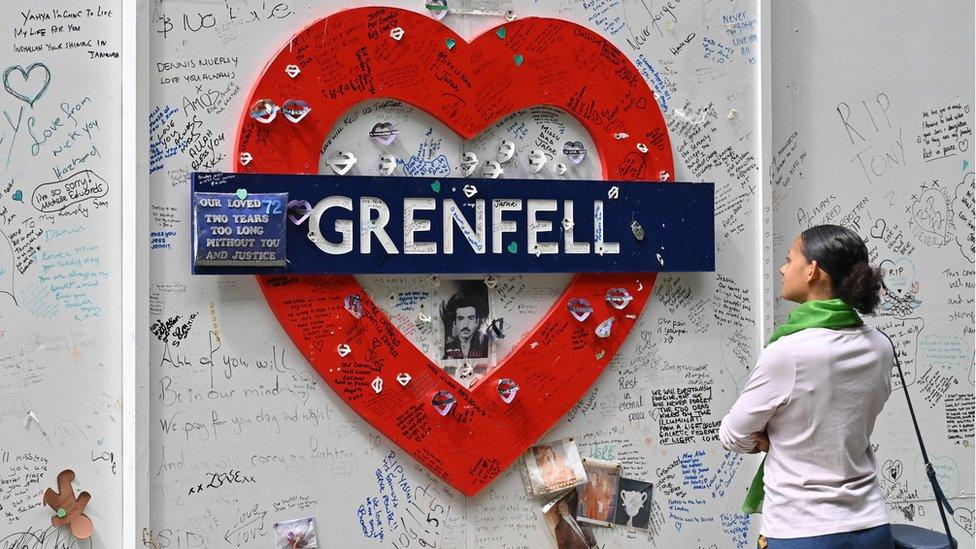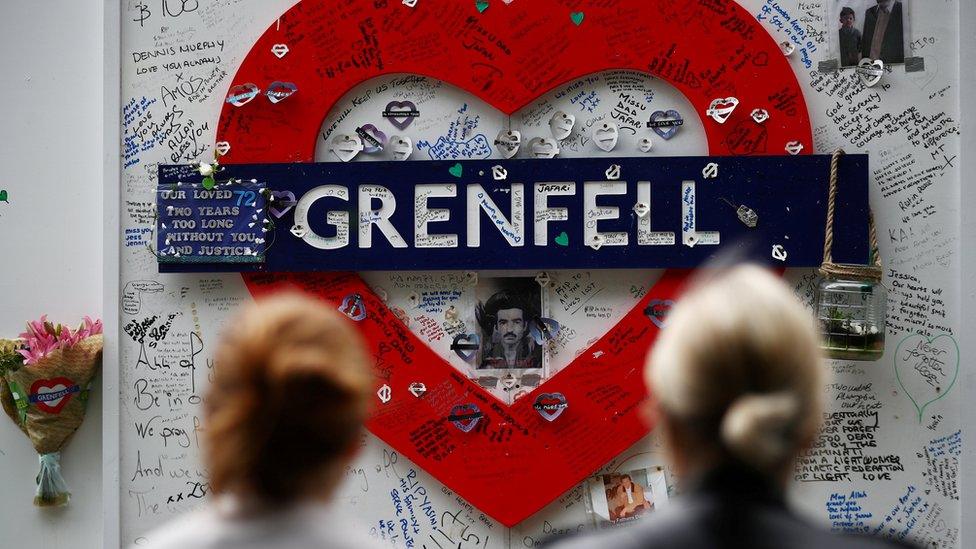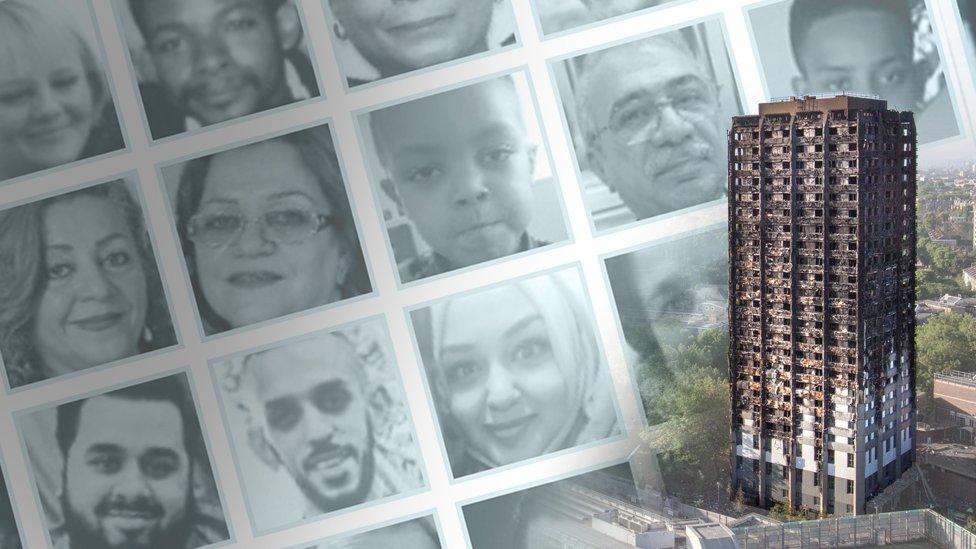Grenfell Tower inquiry: Lead fire consultant 'ignored' cladding email
- Published

People gathered at Grenfell Memorial Community Mosaic at the base of the tower block in London on the third anniversary of the fire
The lead fire safety consultant of the Grenfell Tower refurbishment ignored documents outlining proposed cladding and insulation materials, the inquiry into the fire has heard.
Terry Ashton said he did not read an email from project architects detailing a planned cladding system because he was not the "primary recipient".
The hearing was told he also failed to read the architect's progress report.
The inquiry has concluded that cladding fuelled the 2017 fire in west London.
Hearings in the second phase of the inquiry returned this week after a four-month break due to coronavirus. It is looking at the refurbishment of the residential block in North Kensington in which 72 people died.
Mr Ashton, of fire engineering firm Exova, ignored an email from architecture firm Studio E on 23 October 2012 which included attachments containing details and drawings of a planned cladding system.
Asked why, he told the hearing that people are often copied into emails on big projects in "a sort of scattergun approach".
The inquiry's counsel, Kate Grange QC, asked him: "Wasn't that a really important document prepared by the architects that would inform your work on the outline fire safety strategy?"
Mr Ashton said he would not have read it unless "specifically asked to do so".

People released balloons at the base of the tower block on the third anniversary of the fire
The inquiry also heard that he did not read the architect's progress report which he was sent on 31 October 2012, and failed to mention plans to cover the tower block in cladding at all in his first fire safety report published on the same day.
He said: "Had we had some sort of preliminary details of the cladding for us to consider then we might have incorporated it in the list."
Mr Ashton, a fire consultant of 25 years and with no formal training as a fire engineer, said his main focus was on the refurbishment of the lower four floors of the 24-storey tower block at the time
Ms Grange showed Mr Ashton the architect's 2012 Stage C report - which he was seeing for the first time - that included drawings and proposed cladding and insulation materials.
She asked him whether he agreed that it contained "specific information" about what was proposed, including the type of insulation to be used in the tower block's outer cladding.
He replied: "I can see that now, yes."
The inquiry heard that between October 2012 and November 2013, he produced three issues of a fire strategy report without pressing the architects to ask what materials they planned to use to cover the tower block.
In all three reports he wrote that the proposed changes will "have no adverse effect on the building in relation to external fire spread" adding this would be confirmed by an analysis in a later issue of the report, but no further report was completed.
Mr Ashton denied the lawyer's suggestion that failing to ask for further details on the proposed cladding system had been an "abdication" of his responsibilities.
He said: "I wouldn't put it in those strong terms. We can only react to what we are being given to look at."
He added he accepted that perhaps he should have pursued the architects "a bit more firmly, or at all" to ask about what they were doing about the external walls.
Exova has previously said criticism of it is "unjustified" because it was not consulted about the flammable materials which eventually coated the building in North Kensington.
The firm's counsel, Michael Douglas QC, has told the inquiry the company had been "left out" of planning discussions and had been effectively sidelined after Rydon became the main contractor in 2014.
The inquiry heard on Monday that Dr Clare Barker, the former principal fire engineer at Exova, did not raise the need for any proposed cladding system to have a separate fire safety assessment during a meeting in July 2012.
- Published7 July 2020

- Published6 July 2020

- Published30 May 2018
